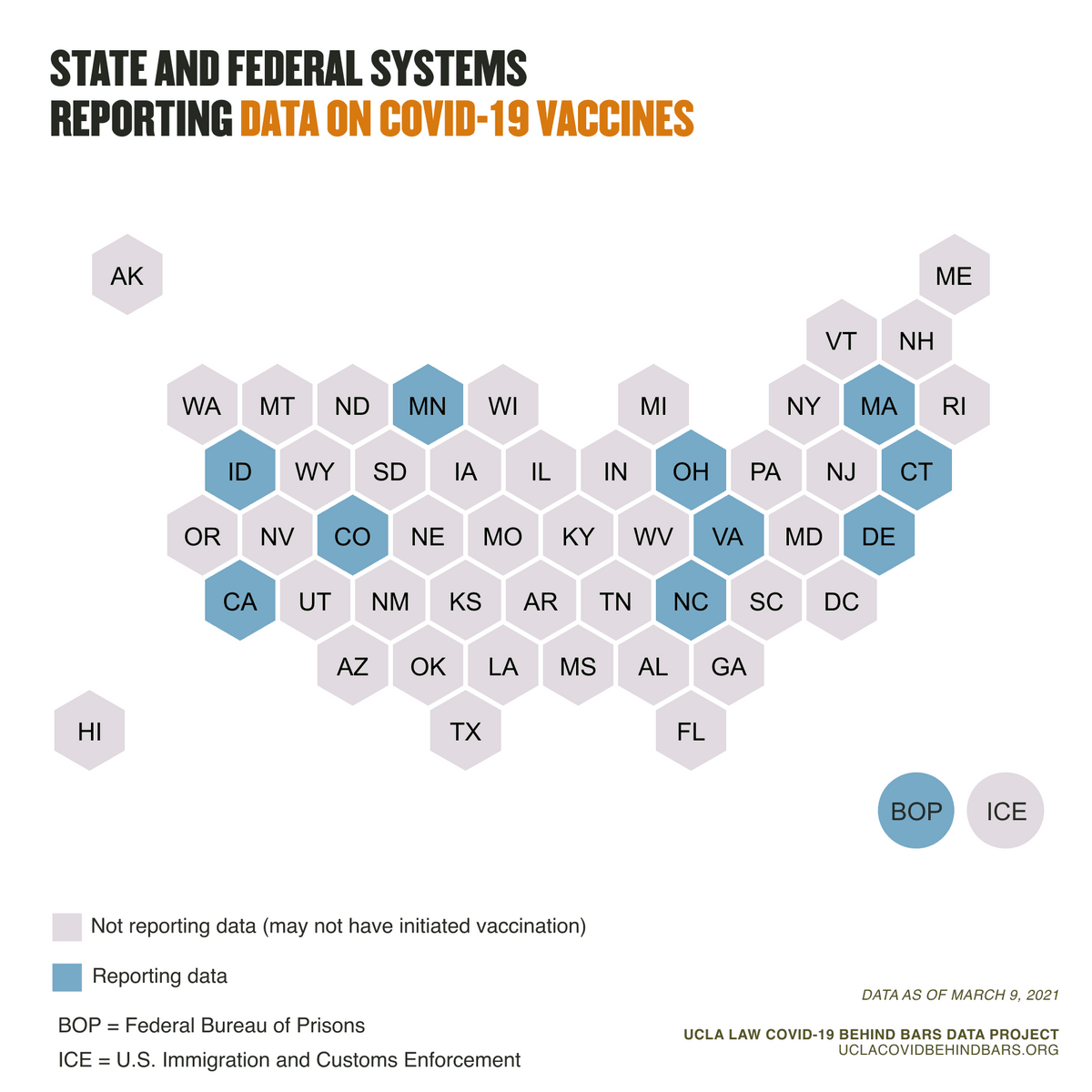March 9th, 2021 • Joshua Manson
Data Project Adds Vaccine Counts to Data Dashboard

With COVID-19 vaccine rollouts underway across the country, the extent to which vaccines have been made available to people living and working in the country’s prisons and jails has become a key point of interest for those tracking the impact of COVID-19 behind bars.
Last week, in an effort to make our data on vaccine distribution readily accessible, the UCLA Law COVID Behind Bars Data Project added a table on our homepage displaying the numbers of incarcerated people and staff who have received at least a first dose of a COVID-19 vaccine within certain state and federal carceral systems.
As of this writing, just eleven agencies, including ten state departments of corrections and the Federal Bureau of Prisons, are reporting this critical information. Though media reports have indicated that additional agencies have begun offering vaccinations to staff and those in custody, we only include information in our dataset that is confirmed and reported by agencies themselves.
Agencies differ in the variables they report related to COVID-19 vaccination. Some report only the number of people who have received at least one dose, while others report only the number who have completed full courses of vaccination, and a few report both. For a number of agencies, the precise definition of reported variables is unclear. In light of evidence that even a first dose of the Pfizer and Moderna vaccines confers a considerable protective effect, we have chosen to organize the data in a way that reflects, to the best of our knowledge, the number of people who have received at least one vaccine dose.
The full range of variables reported can be found in our dataset on GitHub. More information about how we define our variables is available on our methodology page.
Though data showing vaccine acceptance rates are not widely available, some reporting indicates that, at least in some facilities, incarcerated populations appear to be accepting the vaccine at higher rates than jail and prison staff. According to a February court filing, in California, incarcerated people who are aged 65 or older or have certain medical risk factors accepted vaccines at rates exceeding 90%.
Since COVID-19 vaccines have become available, advocates and public health experts have urged political authorities to prioritize incarcerated people along with prison and jail staff for receipt of vaccines. Analyses of our data published in the Journal of the American Medical Association and the American Journal of Preventive Medicine have found that incarcerated people have been infected at case rates five times greater than that of the U.S. population as a whole, and prison staff have suffered a case rate more than three times greater.
In December, more than 500 health and legal policy experts endorsed our sign-on letter urging high vaccine priority for incarcerated populations, equal to that for prison staff. Health experts continue to urge widespread vaccination, paired with decarceration, to slow the spread of COVID-19 behind bars.
Congress is now considering a bill, the COVID-19 in Corrections Data Transparency Act, which would require federal, state, and local correctional facilities to collect and report the numbers of incarcerated individuals and correctional staff who have been given a first dose of a vaccine or are fully vaccinated, along with the numbers of those who declined the offer of vaccination. We strongly endorse this legislation. Transparency around this data is critical if public health authorities are able to develop effective strategies to mitigate the spread of the virus inside carceral facilities and neighboring communities.
In the meantime, we urge all state authorities to offer vaccinations to their incarcerated residents immediately, and to distribute health- and legal-related educational materials to both prison and jail residents and corrections staff as a way to encourage uptake. As they do so, all carceral agencies should publish data tracking vaccine roll-outs. Keeping the public informed about efforts to stop the spread of the virus is no less important when those efforts take place behind bars; in fact, given the disproportionate toll the virus has taken on incarcerated populations, ready access to accurate data concerning what is happening inside should be recognized as an urgent public health priority.
next post
March 17th, 2021 • Liz DeWolf, Poornima Rajeshwar, and Erika Tyagi
Missing the Mark: Data Reporting & Quality Scorecard
We created a scorecard to assess 53 state and federal carceral agencies on what COVID-19 data they report and how they report them. 41 agencies — more than 75% — failed.